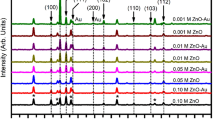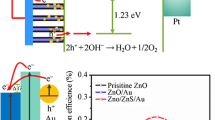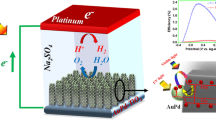Abstract
A facile electron-charging and reducing method was developed to prepare Au/WO3 nanocomposites for plasmonic solar water splitting. The preparation method involved a charging step in which electrons were charged into WO3 under negative bias, and a subsequent reducing step in which the stored electrons were used to reductively deposit Au on the surface of WO3. The electron-charged WO3 (c-WO3) exhibited tunable reducibility that could be easily controlled by varying the charging parameters, and this property makes this method a universal strategy to prepare metal/WO3 composites. The obtained Au/WO3 nanocomposite showed greatly improved photoactivity toward the oxygen evolution reaction (OER) when compared with WO3. After Au decoration, the OER photocurrent was improved by a percentage of over 80% at low potentials (<0.6 V vs. SCE), and by a percentage of over 30% at high potentials (>1.0 V vs. SCE). Oxygen evolution measurements were performed to quantitatively determine the Faraday efficiency for OER, which reflected the amount of photocurrent consumed by water splitting. The Faraday efficiency for OER was improved from 74% at the WO3 photoanode to 94% at the Au-8/WO3 composite photoanode, and this is the first direct evidence that the Au decoration significantly restrained the anodic side reactions and enhanced the photoelectrochemical (PEC) OER efficiency. The high photoactivity of the composite photoanode toward OER was ascribed to the plasmon resonance energy transfer (PRET) enhancement and the catalytic enhancement of Au nanoparticles (NPs).

Similar content being viewed by others
References
Warren, S. C.; Thimsen, E. Plasmonic solar water splitting. Energy Environ. Sci. 2012, 5, 5133–5146.
Linic, S.; Christopher, P.; Ingram, D. B. Plasmonic-metal nanostructures for efficient conversion of solar to chemical energy. Nat. Mater. 2011, 10, 911–921.
Ingram, D. B.; Linic, S. Water splitting on composite plasmonic-metal/semiconductor photoelectrodes: Evidence for selective plasmon-induced formation of charge carriers near the semiconductor surface. J. Am. Chem. Soc. 2011, 133, 5202–5205.
Kim, H. J.; Lee, S. H.; Upadhye, A. A.; Ro, I.; Tejedor- Tejedor, M. I.; Anderson, M. A.; Kim, W. B.; Huber, G. W. Plasmon-enhanced photoelectrochemical water splitting with size-controllable gold nanodot arrays. ACS Nano 2014, 8, 10756–10765.
Pu, Y. C.; Wang, G. M.; Chang, K. D.; Ling, Y. C.; Lin, Y. K.; Fitzmorris, B. C.; Liu, C. M.; Lu, X. H.; Tong, Y. X.; Zhang, J. Z. et al. Au nanostructure-decorated TiO2 nanowires exhibiting photoactivity across entire UV-visible region for photoelectrochemical water splitting. Nano Lett. 2013, 13, 3817–3823.
Su, F. L.; Wang, T.; Lv, R.; Zhang, J. J.; Zhang, P.; Lu, J. W.; Gong, J. L. Dendritic Au/TiO2 nanorod arrays for visiblelight driven photoelectrochemical water splitting. Nanoscale 2013, 5, 9001–9009.
Chen, H. M.; Chen, C. K.; Chen, C. J.; Cheng, L. C.; Wu, P. C.; Cheng, B. H.; Ho, Y. Z.; Tseng, M. L.; Hsu, Y. Y.; Chan, T. S. et al. Plasmon inducing effects for enhanced photoelectrochemical water splitting: X-ray absorption approach to electronic structures. ACS Nano 2012, 6, 7362–7372.
Wu, M.; Chen, W. J.; Shen, Y. H.; Huang, F. Z.; Li, C. H.; Li, S. K. In situ growth of matchlike ZnO/Au plasmonic heterostructure for enhanced photoelectrochemical water splitting. ACS Appl. Mater. Interfaces 2014, 6, 15052–15060.
Thiyagarajan, P.; Ahn, H. J.; Lee, J. S.; Yoon, J. C.; Jang, J. H. Hierarchical metal/semiconductor nanostructure for efficient water splitting. Small 2013, 9, 2341–2347.
Thomann, I.; Pinaud, B. A.; Chen, Z. B.; Clemens, B. M.; Jaramillo, T. F.; Brongersma, M. L. Plasmon enhanced solarto- fuel energy conversion. Nano Lett. 2011, 11, 3440–3446.
Li, J. T.; Cushing, S. K.; Zheng, P.; Meng, F. K.; Chu, D.; Wu, N. Q. Plasmon-induced photonic and energy-transfer enhancement of solar water splitting by a hematite nanorod array. Nat. Commun. 2013, 4, 2651.
Thimsen, E.; Le Formal, F.; Grätzel, M.; Warren, S. C. Influence of plasmonic Au nanoparticles on the photoactivity of Fe2O3 electrodes for water splitting. Nano Lett. 2011, 11, 35–43.
Solarska, R.; Bienkowski, K.; Zoladek, S.; Majcher, A.; Stefaniuk, T.; Kulesza, P. J.; Augustynski, J. Enhanced water splitting at thin film tungsten trioxide photoanodes bearing plasmonic gold–polyoxometalate particles. Angew. Chem., Int. Ed. 2014, 53, 14196–14200.
Solarska, R.; Królikowska, A.; Augustynski, J. Silver nanoparticle induced photocurrent enhancement at WO3 photoanodes. Angew. Chem., Int. Ed. 2010, 49, 7980–7983.
Liu, L. P.; Wang, G. M.; Li, Y.; Li, Y. D.; Zhang, J. Z. CdSe quantum dot-sensitized Au/TiO2 hybrid mesoporous films and their enhanced photoelectrochemical performance. Nano Res. 2011, 4, 249–258.
Sun, Y. H.; Jiang, L.; Zhong, L. B.; Jiang, Y. Y.; Chen, X. D. Towards active plasmonic response devices. Nano Res. 2015, 8, 406–417.
Hartland, G. V. Optical studies of dynamics in noble metal nanostructures. Chem. Rev. 2011, 111, 3858–3887.
Halas, N. J.; Lal, S.; Chang, W.-S.; Link, S.; Nordlander, P. Plasmons in strongly coupled metallic nanostructures. Chem. Rev. 2011, 111, 3913–3961.
Zhang, P.; Wang, T.; Gong, J. L. Mechanistic understanding of the plasmonic enhancement for solar water splitting. Adv. Mater. 2015, 27, 5328–5342.
Pala, R. A.; White, J.; Barnard, E.; Liu, J.; Brongersma, M. L. Design of plasmonic thin-film solar cells with broadband absorption enhancements. Adv. Mater. 2009, 21, 3504–3509.
Catchpole, K. R.; Polman, A. Plasmonic solar cells. Opt. Express 2008, 16, 21793–21800.
Knight, M. W.; Sobhani, H.; Nordlander, P.; Halas, N. J. Photodetection with active optical antennas. Science 2011, 332, 702–704.
Furube, A.; Du, L. C.; Hara, K.; Katoh, R.; Tachiya, M. Ultrafast plasmon-induced electron transfer from gold nanodots into TiO2 nanoparticles. J. Am. Chem. Soc. 2007, 129, 14852–14853.
Kowalska, E.; Abe, R.; Ohtani, B. Visible light-induced photocatalytic reaction of gold-modified titanium(IV) oxide particles: Action spectrum analysis. Chem. Commun. 2009, 241–243.
Kowalska, E.; Mahaney, O. O. P.; Abe, R.; Ohtani, B. Visible-light-induced photocatalysis through surface plasmon excitation of gold on titania surfaces. Phys. Chem. Chem. Phys. 2010, 12, 2344–2355.
Primo, A.; Marino, T.; Corma, A.; Molinari, R.; García, H. Efficient visible-light photocatalytic water splitting by minute amounts of gold supported on nanoparticulate CeO2 obtained by a biopolymer templating method. J. Am. Chem. Soc. 2011, 133, 6930–6933.
Liu, Z. W.; Hou, W. B.; Pavaskar, P.; Aykol, M.; Cronin, S. B. Plasmon resonant enhancement of photocatalytic water splitting under visible illumination. Nano Lett. 2011, 11, 1111–1116.
Tian, Y.; Tatsuma, T. Mechanisms and applications of plasmon-induced charge separation at TiO2 films loaded with gold nanoparticles. J. Am. Chem. Soc. 2005, 127, 7632–7637.
Liu, Y. H.; Gu, Y. S.; Yan, X. Q.; Kang, Z.; Lu, S. N.; Sun, Y. H.; Zhang, Y. Design of sandwich-structured ZnO/ZnS/Au photoanode for enhanced efficiency of photoelectrochemical water splitting. Nano Res. 2015, 8, 2891–2900.
Hodes, G.; Cahen, D.; Manassen, J. Tungsten trioxide as a photoanode for a photoelectrochemical cell (PEC). Nature 1976, 260, 312–313.
Grätzel, M. Photoelectrochemical cells. Nature 2001, 414, 338–344.
Pala, R. A.; Leenheer, A. J.; Lichterman, M.; Atwater, H. A.; Lewis, N. S. Measurement of minority-carrier diffusion lengths using wedge-shaped semiconductor photoelectrodes. Energy Environ. Sci. 2014, 7, 3424–3430.
Coridan, R. H.; Arpin, K. A.; Brunschwig, B. S.; Braun, P. V.; Lewis, N. S. Photoelectrochemical behavior of hierarchically structured Si/WO3 core–shell tandem photoanodes. Nano Lett. 2014, 14, 2310–2317.
Wang, H. L.; Lindgren, T.; He, J. J.; Hagfeldt, A.; Lindquist, S.-E. Photolelectrochemistry of nanostructured WO3 thin film electrodes for water oxidation: Mechanism of electron transport. J. Phys. Chem. B 2000, 104, 5686–5696.
Butler, M. A. Photoelectrolysis and physical properties of the semiconducting electrode WO2. J. Appl. Phys. 1977, 48, 1914–1920.
Berak, J. M.; Sienko, M. J. Effect of oxygen-deficiency on electrical transport properties of tungsten trioxide crystals. J. Solid State Chem. 1970, 2, 109–133.
Wang, G. M.; Ling, Y. C.; Wang, H. Y.; Yang, X. Y.; Wang, C. C.; Zhang, J. Z.; Li, Y. Hydrogen-treated WO3 nanoflakes show enhanced photostability. Energy Environ. Sci. 2012, 5, 6180–6187.
Qin, D.-D.; Tao, C.-L.; Friesen, S. A.; Wang, T.-H.; Varghese, O. K.; Bao, N.-Z.; Yang, Z.-Y.; Mallouk, T. E.; Grimes, C. A. Dense layers of vertically oriented WO3 crystals as anodes for photoelectrochemical water oxidation. Chem. Commun. 2012, 48, 729–731.
Seabold, J. A.; Choi, K.-S. Effect of a cobalt-based oxygen evolution catalyst on the stability and the selectivity of photo-oxidation reactions of a WO3 photoanode. Chem. Mater. 2011, 23, 1105–1112.
Mi, Q. X.; Zhanaidarova, A.; Brunschwig, B. S.; Gray, H. B.; Lewis, N. S. A quantitative assessment of the competition between water and anion oxidation at WO3 photoanodes in acidic aqueous electrolytes. Energy Environ. Sci. 2012, 5, 5694–5700.
Solarska, R.; Jurczakowski, R.; Augustynski, J. A highly stable, efficient visible-light driven water photoelectrolysis system using a nanocrystalline WO3 photoanode and a methane sulfonic acid electrolyte. Nanoscale 2012, 4, 1553–1556.
Hill, J. C.; Choi, K.-S. Effect of electrolytes on the selectivity and stability of n-type WO3 photoelectrodes for use in solar water oxidation. J. Phys. Chem. C 2012, 116, 7612–7620.
Jin, T.; Diao, P.; Wu, Q. Y.; Xu, D.; Hu, D. Y.; Xie, Y. H.; Zhang, M. WO3 nanoneedles/a-Fe2O3/cobalt phosphate composite photoanode for efficient photoelectrochemical water splitting. Appl. Catal. B: Environ. 2014, 148–149, 304–310.
Jin, T.; Diao, P.; Xu, D.; Wu, Q. Y. High-aspect-ratio WO3 nanoneedles modified with nickel-borate for efficient photoelectrochemical water oxidation. Electrochim. Acta 2013, 114, 271–277.
Yan, J. Q.; Wang, T.; Wu, G. J.; Dai, W. L.; Guan, N. J.; Li, L. D.; Gong, J. L. Tungsten oxide single crystal nanosheets for enhanced multichannel solar light harvesting. Adv. Mater. 2015, 27, 1580–1586.
Zhang, J. J.; Zhang, P.; Wang, T.; Gong, J. L. Monoclinic WO3 nanomultilayers with preferentially exposed (002) facets for photoelectrochemical water splitting. Nano Energy 2015, 11, 189–195.
Yang, X. G.; Liu, R.; He, Y. M.; Thorne, J.; Zheng, Z.; Wang, D. W. Enabling practical electrocatalyst-assisted photoelectron-chemical water splitting with earth abundant materials. Nano Res. 2015, 8, 56–81.
Wang, J. M.; Khoo, E.; Lee, P. S.; Ma, J. Controlled synthesis of WO3 nanorods and their electrochromic properties in H2SO4 electrolyte. J. Phys. Chem. C 2009, 113, 9655–9658.
Niklasson, G. A.; Granqvist, C. G. Electrochromics for smart windows: Thin films of tungsten oxide and nickel oxide, and devices based on these. J. Mater. Chem. 2007, 17, 127–156.
Chemelewski, W. D.; Lee, H.-C.; Lin, J.-F.; Bard, A. J.; Mullins, C. B. Amorphous FeOOH oxygen evolution reaction catalyst for photoelectrochemical water splitting. J. Am. Chem. Soc. 2014, 136, 2843–2850.
Xi, G. C.; Ye, J. H.; Ma, Q.; Su, N.; Bai, H.; Wang, C. In situ growth of metal particles on 3D urchin-like WO3 nanostructures. J. Am. Chem. Soc. 2012, 134, 6508–6511.
Tatsuma, T.; Saitoh, S.; Ohko, Y.; Fujishima, A. TiO2-WO3 photoelectrochemical anticorrosion system with an energy storage ability. Chem. Mater. 2001, 13, 2838–2842.
Ngaotrakanwiwat, P.; Tatsuma, T.; Saitoh, S.; Ohko, Y.; Fujishima, A. Charge–discharge behavior of TiO2-WO3 photocatalysis systems with energy storage ability. Phys. Chem. Chem. Phys. 2003, 5, 3234–3237.
Tatsuma, T.; Takeda, S.; Saitoh, S.; Ohko, Y.; Fujishima, A. Bactericidal effect of an energy storage TiO2-WO3 photocatalyst in dark. Electrochem. Commun. 2003, 5, 793–796.
Iwai, T. Temperature dependence of the optical absorption edge of tungsten trioxide single crystal. J. Phys. Soc. Jpn. 1960, 15, 1596–1600.
Jovic, V.; Chen, W. T.; Sun-Waterhouse, D.; Blackford, M. G.; Idriss, H.; Waterhouse, G. I. N. Effect of gold loading and TiO2 support composition on the activity of Au/TiO2 photocatalysts for H2 production from ethanol-water mixtures. J. Catal. 2013, 305, 307–317.
Su, J. Z.; Feng, X. J.; Sloppy, J. D.; Guo, L. J.; Grimes, C. A. Vertically aligned WO3 nanowire arrays grown directly on transparent conducting oxide coated glass: Synthesis and photoelectrochemical properties. Nano Lett. 2011, 11, 203–208.
Hong, S. J.; Lee, S.; Jang, J. S.; Lee, J. S. Heterojunction BiVO4/WO3 electrodes for enhanced photoactivity of water oxidation. Energy Environ. Sci. 2011, 4, 1781–1787.
Burschka, J.; Pellet, N.; Moon, S. J.; Humphry-Baker, R.; Gao, P.; Nazeeruddin, M. K.; Grätzel, M. Sequential deposition as a route to high-performance perovskite-sensitized solar cells. Nature 2013, 499, 316–319.
Walter, M. G.; Warren, E. L.; McKone, J. R.; Boettcher, S. W.; Mi, Q. X.; Santori, E. A.; Lewis, N. S. Solar water splitting cells. Chem. Rev. 2010, 110, 6446–6473.
Kay, A.; Cesar, I.; Grätzel, M. New benchmark for water photooxidation by nanostructured α-Fe2O3 films. J. Am. Chem. Soc. 2006, 128, 15714–15721.
Köntje, C.; Kolb, D. M.; Jerkiewicz, G. Roughening and long-range nanopatterning of Au(111) through potential cycling in aqueous acidic media. Langmuir 2013, 29, 10272–10278.
Zhang, D. F.; Diao, P. Activity and stability of supported gold nano- and submicro-particles toward the electrocatalytic oxidation of carbon monoxide. Appl. Catal. A 2014, 469, 65–73.
Wu, Q. Y.; Diao, P.; Sun, J.; Xu, D.; Jin, T.; Xiang, M. Draining the photoinduced electrons away from an anode: The preparation of Ag/Ag3PO4 composite nanoplate photoanodes for highly efficient water splitting. J. Mater. Chem. A 2015, 3, 18991–18999.
Yeo, B. S.; Klaus, S. L.; Ross, P. N.; Mathies, R. A.; Bell, A. T. Identification of hydroperoxy species as reaction intermediates in the electrochemical evolution of oxygen on gold. ChemPhysChem 2010, 11, 1854–1857.
Diaz-Morales, O.; Calle-Vallejo, F.; de Munck, C.; Koper, M. T. M. Electrochemical water splitting by gold: Evidence for an oxide decomposition mechanism. Chem. Sci. 2013, 4, 2334–2343.
Ye, M. D.; Gong, J. J.; Lai, Y. K.; Lin, C. J.; Lin, Z. Q. High-efficiency photoelectrocatalytic hydrogen generation enabled by palladium quantum dots-sensitized TiO2 nanotube arrays. J. Am. Chem. Soc. 2012, 134, 15720–15723.
Bard, A. J.; Faulkner, L. R. Electrochemical Methods: Fundamentals and Applications; John Wiley & Sons, Inc.: New York, 2001.
Author information
Authors and Affiliations
Corresponding author
Electronic supplementary material
Rights and permissions
About this article
Cite this article
Hu, D., Diao, P., Xu, D. et al. Gold/WO3 nanocomposite photoanodes for plasmonic solar water splitting. Nano Res. 9, 1735–1751 (2016). https://doi.org/10.1007/s12274-016-1067-0
Received:
Revised:
Accepted:
Published:
Issue Date:
DOI: https://doi.org/10.1007/s12274-016-1067-0




